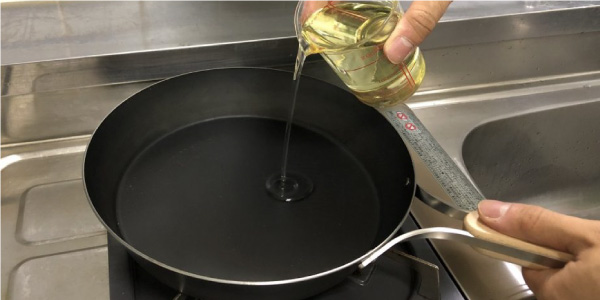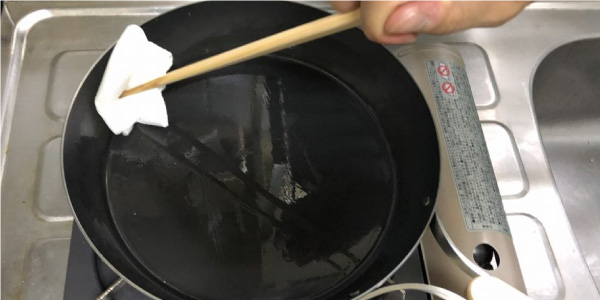About iron products

Contents
- What are the characteristics of iron products?
- What should I do when using an iron product for the first time?
- How do I remove the protective coating?
- How do I season my pot with oil?
- Is seasoning with oil required for all iron items?
- How do I care for my pot on a regular basis?
- My pot always burns on the same spot!
- What to do if my pot rusts?
What are the characteristics of iron products?
The advantages are high heat conductivity and durability. The disadvantage is rusting.
Iron pots are used in professional kitchens and homes to cook Chinese cuisine. They are characterized by high heat conductivity and durability. Nowadays, they are also popular as a means of supplementing iron intake. The disadvantage, on the other hand, is rusting. They rust easily if not regularly maintained.
You don’t have to worry about rusting as long as you care for your pot after every use, and the more you use, the more non-stick your pot becomes as more oil impregnates into the iron. It’s “a tool” you nurture with a sense of attachment.
What should I do when using an iron product for the first time?
Some products require the removal of a protective coating followed by seasoning with oil.
Iron woks or pans usually have a clear protective coating to prevent rusting before delivery. While this coating meets food sanitation requirements and is harmless, it’s still advised to remove the coating before using the product for the first time. Because this coating is baked at a high temperature of about 250 degrees Celsius in the production process, it is chemically stable, there is no adequate solvent agent, and the only way to remove the coating is to burn it completely.
How do I remove the protective coating?
- Turn your gas stove to high and thoroughly bake your pot inside and out.
- This will produce smoke, but it will stop once the coating is completely burnt. (Typically, it takes about 10 to 15 minutes.)
- The pot surface will turn bluish-black, and if the coating still remains on some areas, expose the areas to a flame to completely burn the coating. *Pot will be extremely hot. Exercise caution to avoid burning your skin or surrounding area and ignition.
- Once the coating is entirely burnt and the pot cools down, use dish soap to thoroughly remove the burnt coatings. *Do not put hot pot in water.
- Heat up the pot to completely dry.
How do I season my pot with oil?
After drying your pot, fill the pot to half-full with used cooking oil, spread the oil throughout the pot, and heat the pot for about 3 minutes. *Exercise great caution to avoid oil catching fire. Discard the oil and use kitchen towel or paper to thoroughly wipe inside the pot to allow the oil to impregnate the metal. *Ensure to wipe the edge of the pot also. Thoroughly wipe the outside as well.
To remove the iron smell from shallow items (e.g., wok or pan) when using the item for the first time, fry the green part of green onions, cabbage cores, onions, celery leaves, or scraps of herbs with oil.


Is seasoning with oil required for all iron items?
No, silicon-resin coated items do not require seasoning with oil unlike those with a clear coating.
A characteristic of silicone-resin coated items is that you can start using the for cooking without burning. While the coating will be naturally removed through cooking over time, the coating itself is safe and harmless as it is compliant with the Food Sanitation Act, and even if it gets into your body, it will leave your body without being absorbed. (Harmless to humans)
Refer to surface coating section in the quality label to confirm what coating your pot has.
While pots are resistant to rusting at the beginning because they are protected by a silicone coating film, the film will be removed over time making your pots more prone to rusting. Please apply a thin layer of oil.
How do I care for my pot on a regular basis?
Use items such as a scrubbing brush and warm water to wash.
It’s easier to clean when the pot is still warm. For grime, soak in hot water to soften before washing off. Baking your pot to remove moisture can keep red rust from forming. After cleaning your pot, use kitchen paper to rub oil inside the pot.
My pot always burns on the same spot!
This happens when there is inconsistency in the oil-seasoned surface.
If this occurs, scrub the entire inner surface with a hard object such as a steel brush to remove the existing surface film and season the pot with oil as you would do for a new pot.
What to do if my pot rusts?
Use a sponge or steel brush and polishing powder to thoroughly rub off the rust, then rinse with water.
Sometimes rust can occur even when the pot is being regularly maintained if it’s exposed to moisture without being noticed or stored in a humid space. Use a sponge or steel brush and polishing powder to thoroughly rub off the rusty spots and rinse with water.
Be careful when storing your pots in a storage space under the sink as it is humid, and pots can rust easily if they are not being used frequently.






